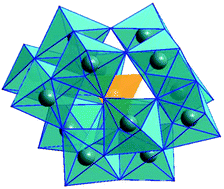A study of the optical properties of metal-doped polyoxotitanium cages and the relationship to metal-doped titania†
Abstract
To what extent the presence of transition metal ions can affect the optical properties of structurally well-defined, metal-doped polyoxotitanium (POT) cages is a key question in respect to how closely these species model technologically important metal-doped TiO2. This also has direct implications to the potential applications of these organically-soluble inorganic cages as photocatalytic redox systems in chemical transformations. Measurement of the band gaps of the series of closely related polyoxotitanium cages [MnTi14(OEt)28O14(OH)2] (1), [FeTi14(OEt)28O14(OH)2] (2) and [GaTi14(OEt)28O15(OH)] (3), containing interstitial Mn(II), Fe(II) and Ga(III) dopant ions, shows that transition metal doping alone does not lower the band gaps below that of TiO2 or the corresponding metal-doped TiO2. Instead, the band gaps of these cages are within the range of values found previously for transition metal-doped TiO2 nanoparticles. The low band gaps previously reported for 1 and for a recently reported related Mn-doped POT cage appear to be the result of low band gap impurities (most likely amorphous Mn-doped TiO2).


 Please wait while we load your content...
Please wait while we load your content...